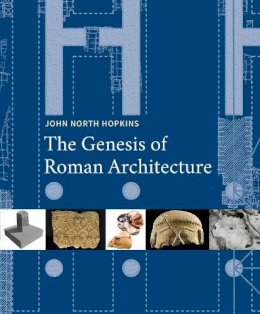
Stock image for illustration purposes only - book cover, edition or condition may vary.
The Genesis of Roman Architecture
John North Hopkins
€ 89.84
FREE Delivery in Ireland
Description for The Genesis of Roman Architecture
Hardback. An important new look at Rome's earliest buildings and their context within the broader tradition of Mediterranean culture Num Pages: 268 pages, 62 color + 58 b/w illus. BIC Classification: 1QDAR; AMX. Category: (G) General (US: Trade). Dimension: 254 x 203. .
An important new look at Rome's earliest buildings and their context within the broader tradition of Mediterranean culture
This groundbreaking study traces the development of Roman architecture and its sculpture from the earliest days to the middle of the 5th century BCE. Existing narratives cast the Greeks as the progenitors of classical art and architecture or rely on historical sources dating centuries after the fact to establish the Roman context. Author John North Hopkins, however, allows the material and visual record to play the primary role in telling the story of Rome’s origins, synthesizing important new evidence from recent excavations. Hopkins’s detailed account of urban growth and artistic, political, and social exchange establishes strong parallels with communities across the Mediterranean. From the late 7th century, Romans looked to increasingly distant lands for shifts in artistic production. By the end of the archaic period they were building temples that would outstrip the monumentality of even those on the Greek mainland. The book’s extensive illustrations feature new reconstructions, allowing readers a rare visual exploration of this fragmentary evidence.
This groundbreaking study traces the development of Roman architecture and its sculpture from the earliest days to the middle of the 5th century BCE. Existing narratives cast the Greeks as the progenitors of classical art and architecture or rely on historical sources dating centuries after the fact to establish the Roman context. Author John North Hopkins, however, allows the material and visual record to play the primary role in telling the story of Rome’s origins, synthesizing important new evidence from recent excavations. Hopkins’s detailed account of urban growth and artistic, political, and social exchange establishes strong parallels with communities across the Mediterranean. From the late 7th century, Romans looked to increasingly distant lands for shifts in artistic production. By the end of the archaic period they were building temples that would outstrip the monumentality of even those on the Greek mainland. The book’s extensive illustrations feature new reconstructions, allowing readers a rare visual exploration of this fragmentary evidence.
Product Details
Publisher
Yale University Press United States
Number of pages
268
Format
Hardback
Publication date
2016
Condition
New
Weight
1257g
Number of Pages
268
Place of Publication
, United States
ISBN
9780300211818
SKU
V9780300211818
Shipping Time
Usually ships in 7 to 11 working days
Ref
99-35
About John North Hopkins
John North Hopkins is assistant professor of art history and classical studies at Rice University.
Reviews for The Genesis of Roman Architecture
"[An] engrossing account ... Even when texts and objects seem to point in the same direction, it takes a generous dose of ingenuity to weave together a credible story from such random clues-part of archaeology's eternal fascination. Hopkins is a master of this exacting art."-Ingrid D. Rowland, New York Review of Books
Ingrid Rowland The New York Review of Books "A valuable contribution to the study of early Rome... There is little published, or unpublished, that escapes [Hopkins's] notice."-Seth Bernard, American Journal of Archaeology
Seth Bernard American Journal of Archaeology "Hopkins has written nothing less than a highly original history of early Rome, based on a balanced and up-to-date reading of the available archaeological evidence... This is an important book and highly recommended to anyone interested in the art, architecture and society of early Rome."-Dominik Maschek, Bryn Mawr Classical Review
Dominik Maschek Bryn Mawr Classical Review
Ingrid Rowland The New York Review of Books "A valuable contribution to the study of early Rome... There is little published, or unpublished, that escapes [Hopkins's] notice."-Seth Bernard, American Journal of Archaeology
Seth Bernard American Journal of Archaeology "Hopkins has written nothing less than a highly original history of early Rome, based on a balanced and up-to-date reading of the available archaeological evidence... This is an important book and highly recommended to anyone interested in the art, architecture and society of early Rome."-Dominik Maschek, Bryn Mawr Classical Review
Dominik Maschek Bryn Mawr Classical Review
